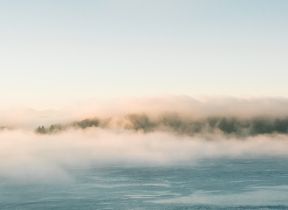8 facts about fog
Fog is one of the most common weather conditions in the UK, particularly throughout autumn and winter, but do you know when fog becomes mist, or how you can catch fog?
It is one of the more common weather conditions in the UK, particularly throughout autumn and winter, but do you know when fog becomes mist, or how you can catch fog? We've put together a list of some of the stranger things you might not know about fog.
1. Fog bow
As the name might suggest, a fog bow is a rainbow that appears in fog rather than during rainfall.
They are fainter and slightly harder to see than rainbows, but you are more likely to see the complete circle of the optical effect.
Because the water droplets that make fog are smaller than raindrops, the full spectrum of colours in a fog bow are hard to distinguish and generally appear as a bow of faint red and blue.
2. The foggiest place in the world
The title of foggiest place in the world goes to an area of the Atlantic Ocean called Grand Banks, lying off the coast of Newfoundland.
The area forms the meeting place of the cold Labrador Current from the north and the much warmer Gulf Stream from the south. This mixture of currents regularly causes the formation of fog, with over 200 days of fog every year.
3. Brewing in the desert
In desert areas where there is little rainfall, fog can serve as a valuable source of water.
The Atacama Desert in Chile is one of the driest areas in the world. Early in the 20th century, it went a parching 173 months without rain.
It does, however, experience frequent fog which moves in from the coast, which the locals affectionately call camanchaca meaning 'creeping fog.'
Large nets are used to 'catch' the fog with tiny 1 mm openings accumulating the tiny water droplets which drip off into a gutter, which collects the water.
An average size fog catcher of 40 m3 can capture up to 66 litres of water a day. This is plentiful enough to supply a brewery which creates 24,000 litres a year of its signature beer Atrapaniebla (meaning "Fog Catcher").
4. Hiding in the fog
On 27th August 1776, George Washington and his troops were fighting a losing battle against the British during the Battle of Long Island. Sensing they were beginning to be surrounded required an opportunity to retreat.
A heavy fog descended on the area, providing Washington just the time and cover he needed to retreat 9,000 of his men into Manhattan. As the fog cleared the British descended on the American positions to find them empty. The Americans' miraculous retreat avoided heavy casualties at a pivotal early battle in the American War of Independence.
5. Shifting perceptions
When driving, most people are aware of the need to slow down in foggy conditions, but did you know fog has a hazardous impact on your speed perception?
Much of how our brains judge speed is by the contrast in our surroundings, such as trees or buildings flashing past in our peripheral vision. But in foggy conditions, contrast is greatly reduced giving the impression you are driving slower than you actually are. Many drivers increase their speed as a result.
6. How much water is in fog?
Fog is made up of tiny water droplets all suspended in what is essentially a cloud on the ground which contains up to 0.5 ml of water per cubic metre.
To visualise this, if you were to fill an Olympic sized swimming pool with fog and then somehow condense it, you would be left with around 1.25 litres of water (or just over 2 pints).
7. The Piedmont nebbia
In Italy's largest wine-growing region, Piedmont, the major growing hills of Langhe and Monferrato are frequently shrouded in thick blankets of fog.
So notorious is the fog that one of its major wines is named after the Italian word for fog, 'nebbia'.
Nebbiolo grapes ripen later in the year and are generally not harvested until late October, by which time fog is a frequent visitor creating spectacular vineyard vistas and a world-class wine.
8. Clearing up the difference
You'll often hear mist and fog mentioned alongside each other, but what makes one morning 'misty' and another 'foggy.'
The difference is a simple matter of how far you can see through it.
If you can see more than 1,000 metres it's called mist, but if it is thicker and the visibility drops below 1,000 metres it's called fog.





